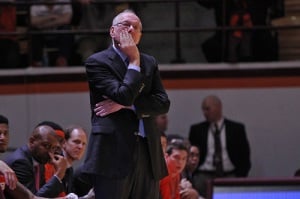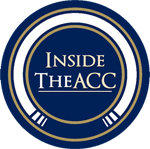Out of all that came from Selection Sunday, this was the most surprising outcome in the ACC.
Actually, maybe not surprising.
Just plain weird.
I would say that Syracuse’s inclusion in the field of 68 was the most unexpected result of Sunday’s Selection Show, but that distinction goes first to CBS for brutally dragging out said show, and then to the Tulsa Golden Hurricane.
Tulsa (20-11) made the field despite being blown out by Memphis in the first round of the American Athletic Tournament (their second double digit loss to the struggling Tigers in two weeks) and finishing with a record of 10-11 against teams in the Top 200 of the RPI.
But I digress.
On an evening that ended with as many questions as answers, how did ‘Cuse make the field?
Schedule
On the court, the Orange took advantage of a big stage early in the season, winning the “Battle 4 Atlantis” in the Bahamas by taking down the likes of 18th-ranked UConn, as well as No. 25 Texas A&M prior to holding the trophy.
Once getting into conference play, it’s undeniable that playing in the ACC has a great deal to do with the Orange escaping the bubble and heading into the Big Dance as a 10-seed. Although a tournament team, losing to Pittsburgh three times certainly hurt, and falling to Florida State in the second-to-last regular season game was nothing to write home about either. However, despite the conference record not being too flattering, some of their nine ACC victories were. Most notably, Syracuse was able to win at No. 25 Duke (no cakewalk at Cameron Indoor), as well as utterly dismantling Notre Dame by 15 at the Carrier Dome.
That’s four tournament teams that Syracuse was able to defeat, with three out of the four being seeded 6th or higher (Texas A&M 3-seed, Duke 4-seed, Notre Dame 6-seed, UConn 9-seed). While it is only a four game sample size, these games were likely a major reason why the Pittsburgh losses were offset.
However, when looking at the total body of work, the case for Jim Boeheim’s club to be in the field is mediocre at best. Syracuse finished the season 19-13, going 9-9 in the ACC. If you’re willing to count the conference tournament they actually finished 9-10 in the conference, after they ended their season with a swift second round exit in the ACC Tournament to Pittsburgh — their third loss of the year to Jamie Dixon’s club. The loss capped off a stretch for Syracuse in which they dropped five out of their last six to close the season leaving much to be desired for a team that many believe underachieved. Additionally, with an 8-10 record overall against teams in the Top 100 of the RPI, the only argument that can potentially be made is that Syracuse challenged themselves with their schedule.
That argument about the schedule, for what it’s worth, is a complete cop-out. Take Monmouth for example. The Hawks went 27-7 including a 17-3 record in the MAAC. A total of 17 of those games were true road match ups, with 24 games in total being played away from their home court. They only had three losses in conference play, but all were against teams outside of the top 200 in the RPI which is why NCAA Selection Committee Chair Joe Castiglione claimed that they were left out.
It’s bogus. It really, truly is. The three losses in conference play were all on the road. If you’re the Selection Committee, you’re going to “reward” teams for challenging themselves in the non-conference, yet strike yourself as surprised when a team drops three conference games away from home?
Monmouth had an RPI of 53, with road wins against Notre Dame and USC. They went on the road and defeated Georgetown and UCLA.
Syracuse, who made the field, lost to Georgetown, who finished the year with a losing record at 15-18 and finished 8th in a weak Big East. Also, Syracuse somehow managed to lose to St. John’s, who may as well have suited up five equipment managers with how disconnected they looked on offense for much of the season.
Monmouth additionally had more road wins than any team on the bubble, doing legitimately everything in their power short of winning their conference title game to be into the field. The naysayers will point to the automatic bid that comes with winning a conference tournament and will discount the Hawks to which I say this:
1) It shouldn’t have mattered with Monmouth as their schedule, RPI, and overall record should have been more than palatable enough for them to make it into the field.
2) Auto-bids are a joke. Holy Cross won their conference tournament and is in the field as a 16-seed with a 14-19 record. If that’s not enough to do away with ridiculous auto-bids, then I don’t know what could possibly change the NCAA’s mind down the road.
Long story short, don’t discuss scheduling if it’s not going to be level across the board. To spin-off Whose Line is it Anyway, welcome to Selection Sunday, where criteria is made up and the facts don’t matter.
The Boeheim Effect
Almost ironically, an argument could be made that the Orange actually benefited from coach Jim Boeheim’s nine-game suspension prior to conference play after the long-winded investigation into the widely publicized academic scandal surrounding the basketball program in upstate New York.
Initially, Castiglione mentioned that the 4-5 record under interim coach Mike Hopkins was not considered when evaluating the resume for the Orange. In later interviews, Castiglione recanted, mentioning that the committee was concerned only with the totality of the body of work, although having nearly one-third of your games coached by an assistant does alter the lens in which the team is viewed.
So now in today’s NCAA world where almost anything goes, you get a pass for faltered play during a punishment for cheating? Interesting.
Conclusion
At the end of the day, Syracuse is in.
They are more than capable of winning a couple of games that are in front of them, especially with an extremely high 10-seed given their resume. However, whether or not they go on a run should not dictate whether the correct decision was made. Monmouth, St. Bonaventure, St. Mary’s, South Carolina, and San Diego State were all capable of winning games in March, so toss-out those thoughts as well when making your own evaluation of some of the last teams in the bracket.
I was one of many to publicly state on Twitter and radio that the Orange would be in the field with a couple of wins in the ACC Tournament last week. After an early exit in the ACC’s paint me surprised, but not shocked that ‘Cuse snuck into the 68. Not with this Selection Committee and the current state of the NCAA under the reign of Mark Emmert.
Do better, NCAA. Do better.
Stay locked in to InsideTheACC for all of your NCAA Tournament news and analysis. As always, thanks for reading! Follow me on Twitter @MikeMcDanielACC and check out InsideTheACC on Facebook and on Twitter @InsideTheACC.



